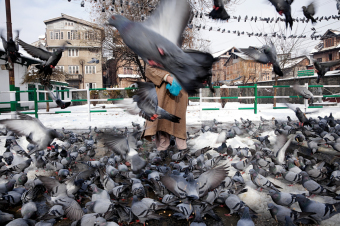Yes, but no need to FREAK OUT
Recounting her brief terror-stricken encounter with a snake in her backyard, Charlane Pereira e Rebello tracks down some popular myths about snakes and details the snake-bite protocol from her educative chats with snake catchers and herpetologists….
It was past eight O’clock where the night cast ghastly shadows. Fluffy, one of our cats stared suspiciously in the distance, refraining from licking her fish bones (given felines’ instinctual hunger for fishes, this was a sure sign of something seriously amiss). My eyes scouted for any movement in the shadows. Nothing! Could it be a rat or some other scavenger of the night? And then something moved. Rather slithered several inches forward. Oh yes! There it was… A poisonous viper!
I am fully committed to women’s liberation, except for when it comes to reacting to creepy reptiles. My first phone call was to hubby, who, working late at the office, promptly took matters into his own hands by putting them into someone else’s. He made a frantic call to a snake catcher whose number was fortunately saved in his contact list, thanks to his previous encounters with the reptilian creatures prior to our marriage…. Phew!
The snake catcher was busy with another creepy call and our anxious summons meant a forty-five-minute ride for him. I had serious doubts this viper would be happy to luxuriate in the same spot for such a long time. Nor was I birdbrain enough to venture out on my own to keep track of its movements. After all, I had grown up hearing that any contact with a viper’s urine would result in the rotting of my flesh (which, by the way, I’m very much attached to!)
No more sighting of the viper after half an hour when I peeped through the backdoor. Sigh of relief! I cancelled the snake catcher’s visit. Ok, so the incident ended without the anticipated tragedy. Still, the whole thing got me wondering, would my flesh REALLY have rotted? I decided to educate myself on the topic.
Nirmal Kulkarni, herpetologist and wildlife photographer, and a member of Goa State Wildlife Advisory Board says, “There is no one specific simple single rule for identifying a venomous snake, as many non-venomous ones have evolved to look like their venomous brethren. However, some (venomous snakes) can be recognized by their shape, size, color, behavior and sound they make when they are threatened.”
He continues, “Venomous snakes (that can cause serious harm) have a pair of enlarged teeth, the fangs, at the front of their upper jaw. These fangs contain a venom channel or groove, along which venom can be introduced deep into the tissues of their natural prey. If a human is bitten, venom is usually injected subcutaneously or intramuscularly. These species are Spectacled Cobra or Common Cobra, Russell’s Viper, Saw Scaled Viper, Common Krait, King Cobra, Pit Vipers.”
Many popular beliefs about snakes run amok in our Goan villages. Surprise, surprise! Many are not true.
Aaron Fernandes, a snake catcher based in Siolim says, “Local beliefs and misconceptions influence people’s reactions to them.” He points to one common myth is that female cobras can fly. “Cobras don’t have wings to fly,” he says. Another false notion, he continues, is that the Sand Boa, or Malun in the local parlance, has two heads. And yes, the belief that a Russell’s viper urine or mere touch can cause rotting of the flesh is just a myth, he says.
A doctor who preferred to stay anonymous opines that panic is a bigger problem than venom. “It is best to stay calm when bitten and seek medical help at the Government hospitals where the anti-venom is available. All snakes are not poisonous. But laypeople assume that every snake is a venomous one and they will die from a non-venomous snake bite. People need to be armed with knowledge.”
Nirmal Kulkarni says the most important thing is to get immediately medical help and avoid traditional remedies that medical science has proven to “be useless or even frankly dangerous.”
He explains, “These methods include: making local incisions or pricks/punctures at the site of the bite or in the bitten limb, attempts to suck the venom out of the wound, use of black ‘snake stones’, tying tight tourniquets around the limb, electric shock and even application of chemicals, herbs or ice packs.”
“I have sadly seen many local people have great confidence in traditional treatments, but they must not be allowed to delay medical treatment.”
Kulkarni’s advice – Recommended First Aid protocol for snake bites
• Reassure the victim who may be very anxious.
• Immobilize the bitten limb with a splint or sling (any movement or muscular contraction increases absorption of venom into the bloodstream).
• Consider pressure immobilization for bites by elapid snakes like the Indian Cobra, the Indian Krait or sea snakes, but not for viper bites. There is considerable debate about this technique, but using a local compression pad applied over the wound pressure bandaging of the entire limb can be very effective.
• Avoid any interference with the bite wound as this may introduce infection, increase absorption of the venom and increase local bleeding.
• The patient must be transported to a place where they can receive medical care (dispensary or hospital) as quickly, safely and comfortably as possible. Any movement, especially of the bitten limb, must be reduced to an absolute minimum to avoid increasing the systemic absorption of venom.
• Remove watches/rings/other jewelry from the site of the bite and do note the time of the bite and sequence of symptoms.
• If possible, the patient should not be allowed to walk and carried with the help of a stretcher or bed or sitting on a chair.
• The best possible first aid for a venomous snake bite victim would be to rush him/her to the nearest hospital in the least possible time.



